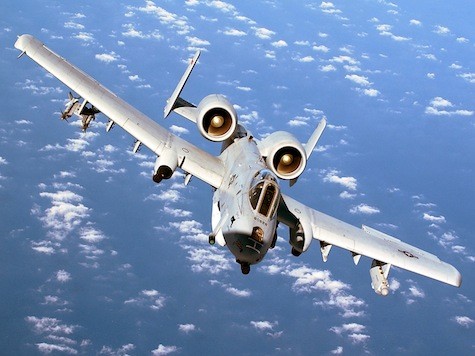Since the dawn of air warfare, every pilot has imagined himself tearing across the Wild Blue Yonder in pursuit of enemy aircraft to shoot down. Many have done just that and have swept the skies so clear of the enemy that the last time an American ground soldier was killed by an enemy aircraft was in April 1953.
But until America has to fight a peer’s air forces, the most common and important Air Force core mission is close air support: “CAS.” It’s not as sexy a mission, but – as the Iraq and Afghanistan wars, and the new ISIS war prove – it’s the dominant air war task of the Air Force, Navy and Marines.
The Air Force’s two principal CAS aircraft are the AC-130 – a lumbering cargo plane configured with enough firepower to level a small city – -and the A-10, which is the only aircraft that was designed specifically for the CAS mission. Their effectiveness is measured in terms of lives saved. In one account related to me by one of the warriors wounded in the firefight, a SEAL platoon was ambushed in Iraq and its lieutenant severely injured by several machine gun bullets, one of which nearly tore his face off. Almost all of the others were wounded when a petty officer managed to call in fire from an AC-130, walking its 20mm cannon fire into and across the enemy positions which were within ten or twenty yards of the SEALs.
You can’t do that with other kinds of aircraft, as was tragically proven in a June 9 incident in Afghanistan when the Air Force tried to perform CAS with a B-1 supersonic bomber. Poor training, the wrong aircraft and – perhaps – negligence by an Air Force attack controller led to the deaths of five American soldiers.
The problem is that the Air Force doesn’t want to “own” the CAS mission. Since the A-10 was created, many argue that CAS has always been an orphan in the Air Force’s planning, budgeting and training. That may be going too far, but it is clear that the Air Force doesn’t want to “own” CAS by devoting the resources needed to perform CAS. Now, it’s pulling out all the political stops to retire the A-10 “Warthog.”
According to a Fox News report earlier this week, the Air Force claims that it will save $4.2 billion (over how many years we don’t know) by retiring the A-10, but Congress isn’t going along with the plan. And this is where politics intervenes. That report quotes Air Force Lt. Gen. Christopher Bogdan as saying that unless the A-10 is retired, the F-35 will be starved for experienced aircraft maintenance men.
And there’s the real problem. The F-35 – which should be known as the fighter that ate the defense budget – is enormously expensive, about twice the cost per aircraft that was agreed to in its original 2001 contract. The technical design problems with the F-35 are nearly legendary and too many are still being worked out. The F-35 was put into production even though the design hasn’t been finalized. And in 2011, testimony to the Senate Armed Services Committee, Ashton Carter–then the undersecretary for acquisition, technology, and logistics, later the deputy secretary of defense– said that, on top of the (then) $385 billion production cost of the aircraft, the cost of maintaining the F-35 through its service life was $1 trillion, making it unaffordable by any measure.
There is no substitute for an Air Force-owned CAS mission. The Army can’t perform it with helicopters, which can be shot down with MANPADs, the shoulder-fired missiles which are common on too many battlefields. Even after the Marine Corps fields its version of the F-35 – which won’t be until at least July 2015 – there will be no other service that can do what the Air Force can with its A-10s and AC-130s.
Air Force Chief of Staff Gen. Mark Welsh should think long and hard about retiring the A-10. Budgets are tight, and will be so for the foreseeable future. But the Air Force has three primary missions: air superiority, CAS and the nuclear deterrent force. It remains to be seen if the F-35 can perform any of them. Until then, none of the core missions can be sacrificed on the F-35 altar.
Jed Babbin served as a deputy undersecretary of defense in the George H. W. Bush administration. He is a senior fellow with the London Center for Policy Research and the author of several books, including “In the Words of Our Enemies,” and “The BDS War Against Israel.

COMMENTS
Please let us know if you're having issues with commenting.